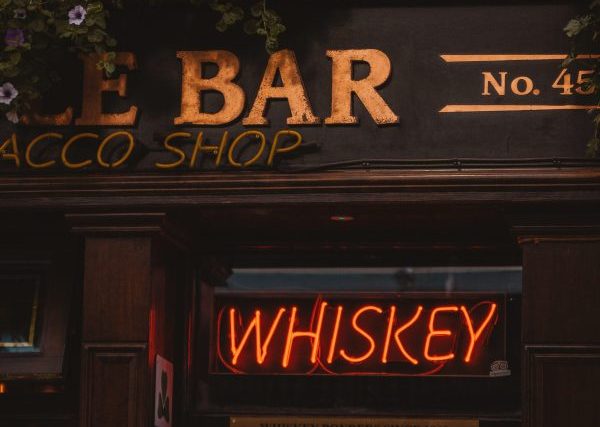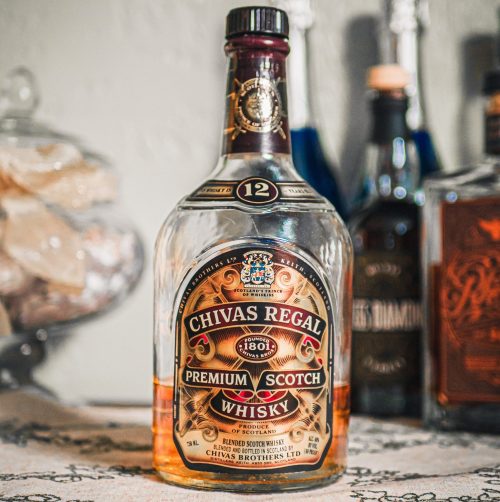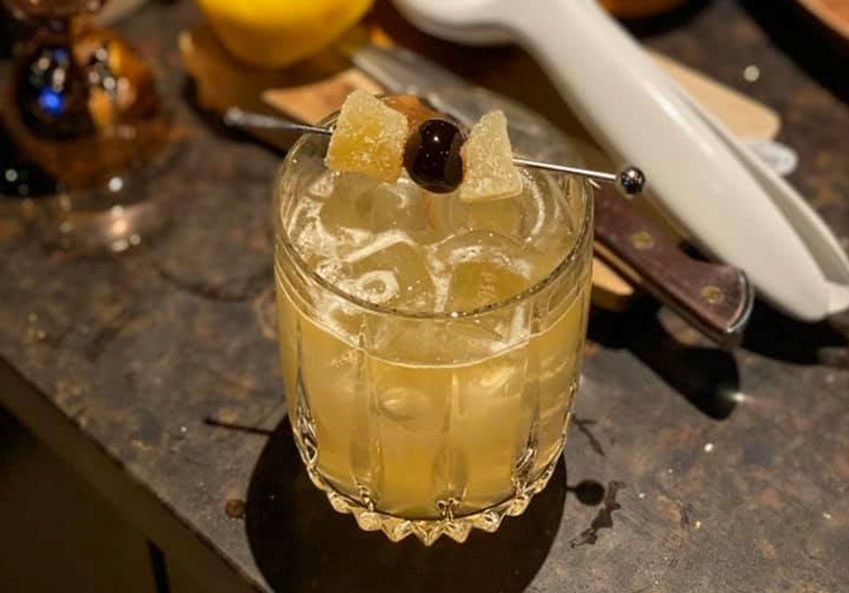
Smoky Whiskey Cocktails
You’ve likely found yourself at a bar and overheard someone ask the bartender for a smoky cocktail. Maybe you’ve even tried and enjoyed one yourself. Maybe there was fire involved, or perhaps the smoky aspect came from the spirit itself. Today we’re talking about the latter – more specifically, smoky whiskey.
Around The World of Smoky Whiskey
When it comes to smoky spirits, smoky Islay Scotch Whiskies are what typically come to mind. Whiskies from Scotland’s isle of Islay are notable for their heavily peated (see the section on how whiskey gets its smoke), smoky, medicinal, briny notes. Classic examples of a heavily peated Islay Scotch are Lagavulin 16 Year Single Malt and Laphroaig 10 Year Single Malt.
Although Islay Scotch Whisky is the most common smoky whisky, there are examples from many other countries, like Ireland, Japan, and even the United States. Connemara from Ireland, Hakushu from Japan, and Balcones “Brimstone” from Texas, US are all great examples of smoky whiskey from around the world.

Photo by Andrea Ferrario via www.unsplash.com
How Whiskey Gets its Smoke
Understanding a bit about how whiskey is made will help you understand this process better. Here’s how it works:
- Cereal grains are mashed (soaked in water and heated) to extract sugars from the grains, like making a really big bowl of oatmeal.
- The resulting mash is left out to naturally ferment, which turns it into “beer” at around 15% ABV. (If you were to drink it at this point, you’d find it pretty boozy and quite sweet).
- The grains are strained out of the beer, and the resulting liquid is distilled by heating it and collecting the steam. (Alcohol evaporates before water, so collecting the alcohol vapor first will concentrate the alcohol while purifying the spirit at the same time).
- The spirit is collected and transferred to wooden barrels to age.

Photo by Josh Appel via www. unsplash.com
Who Smoked All My Whiskey?
The traditional way a whisky becomes smoky happens long before the distillation process begins, shortly after the grains are harvested. In the case of an Islay Scotch, the grain is barley. The barley is first malted, a process of sprouting the seeds to the point that some starches are broken down and enzymes are produced that can convert the starches into sugars. Then the malted barley is dried to stop the germination of the seed, and that’s where the smoke comes in.
Peat moss is plentiful in the Islay region, making it a natural fuel source; it’s burned to create a low-temperature fire, gently drying out the malted barley. When you burn peat moss, it gives off an intensely aromatic and flavorful smoke, which clings to the malted barley. That flavor is carried all the way through the process of distillation and aging, ending up in the bottle.
In American whiskeys, hardwoods, like mesquite and hickory, are commonly used instead of peat moss to accomplish a similar result. Rather than smoking the barley, the grain might be something decidedly more American, like corn.
Another way to get smoke into whiskey is by infusing the unaged spirit with smoke prior to aging, similar to how individual cocktails can be smoked by placing a glass upside down over burning herbs or spices. Other methods of getting smoke into the spirit include:
- aging in exceptionally charred barrels
- aging in barrels that previously held Islay Scotch whisky
- running the spirit through a still that previously distilled a heavily peated malt
Smoky Whiskey Cocktails
Now that you know how and why the whiskey in the bottle is smoky, let’s make some delicious cocktails with it! Here is a selection of smoky whiskey cocktails shared on our Craft Cocktail Club Facebook group.
Penicillin no. 2
Penicillin no. 2 is the first of a few riffs on the modern classic Penicillin cocktail created by Sam Ross at Milk & Honey in New York City. The Penicillin is likely the most popular smoky scotch cocktail in the world. It uses a less peaty blended scotch for the base spirit and a float of the very smoky Lagavulin 16 as an aromatic garnish.
2 oz blended scotch (I used Exceptional Malt)
3/4 oz fresh lemon
3/8 oz honey syrup
3/8 oz ginger syrup
Instructions: Shake in your cocktail shaker with ice, and then strain over ice in a chilled rocks glass. Then layer a spoon of Islay scotch (I used Lagavulin 16) over the top. Garnish with candied ginger (made from the ginger pieces I’d boiled into the syrup) and a Filthy Cherry.
To make the ginger syrup, dissolve a cup of sugar into 3/4 cup water. Then add about a cup of freshly sliced ginger and boil for 15 minutes. Let cool.
The Rising Sun Penicillin
Another riff on the Penicillin cocktail swaps Japanese whisky for the base spirit and uses a float of smoky Japanese whisky for an aromatic garnish.
2oz Suntory Toki Whisky
0.5oz Lemon Juice
0.5oz Yuzu Juice (infused with Lemongrass & Kaffir Lime leaves)
0.3oz Spiced Earl Grey Honey Syrup
0.5oz Caramelized Hawaiian Ginger Syrup
1 Dash Aromatic Bitters
20ml (0.67oz) Nikka Pure Malt Whisky -for float on top
Instructions: Add the first 6 ingredients to a shaker tin with ice and lightly shake for a few seconds. Fine strain cocktail over large ice cubes. Gently float Nikka Pure Malt over ice cubes, and then rest skewered honeycomb on top of ice.
Smoke over Bloody Sands
By Orre Harris
This is a fresh take on the classic Blood and Sand cocktail featuring blood orange juice, a Cabernet Sauvignon reduction, and homemade sour cherry jam.
60ml (2oz) Talisker Storm Scotch Whisky
30ml (1oz) acid-adjusted Blood Orange juice (by adding citric acid)
22.5 ml (.75oz) Cabernet Sauvignon Reduction (aged Cabernet Sauvignon Wine which I reduced with pure cane sugar and clove, allspice, and cinnamon)
1 bar spoon Sour Cherry Jam (sour cherries, lemons, rhubarb, pectin, cane sugar)
Ardbeg 10 Float
Instructions: Add everything but the Ardbeg to a cocktail shaker, shake with ice, and fine strain over one large cube in a rocks glass. Float one bar spoon of Ardbeg 10 on top of the cube and garnish with a dehydrated Blood Orange Wheel.
Harvest Moon
This spirit-forward, bitter, herbal cocktail is sure to warm your soul, like sitting by the campfire during harvest.
0.5oz Ardbeg 10yr Scotch Whisky
0.5 oz High West Campfire Whiskey
1 oz Cappelletti Aperitivo
1 oz Amaro Nonino
1 oz Apricot/Lemon/Turmeric Cordial
1 bar spoon pressed ginger juice
1 dash angostura bitters
2 dashes ginger bitters
Garnish: candied ginger & cherry
Instructions: Shake & double strain into a coupe
To make the apricot/lemon/turmeric-infused rum, combine lemon peels, peeled & grated turmeric, and overproof rum. Sous vide four hours at 130ºF; or store in a dark, cool place for 2-3 days, then strain.
To make apricot syrup: 1:1 ratio apricot nectar & sugar, sous vide 130ºF for four hours, or bring to a low simmer for ~30mins.
To complete the apricot/lemon/turmeric cordial, combine roughly equal parts of the infused rum & apricot syrup, going a little heavier on the syrup since apricot is a light flavor.
Cold Girl Fever
Adapted from the book Cocktail Codex, by Paula Janine Catolico
This Old Fashioned variation incorporates a 1/4 oz of peaty Scotch whisky to add complexity and depth and homemade raisin syrup as a unique sweetener.
1 3/4 oz Singleton Glendullan 12yo
1/4 oz Talisker 10yo
1 teaspoon homemade raisin honey syrup
2 dashes Angostura
Garnish: 1 orange twist and 1 lemon twist
Instructions: Stir all ingredients over ice and strain into a rocks glass over 1 large ice cube. Express the orange twist over the cocktail and gently rub it around the rim of the glass and insert into the drink. Express the lemon twist over the drink and then place it into the drink. Do not rub the lemon twist around the glass as its citrus notes are too overpowering.
Raisin Honey Syrup:
200g honey
200g water
80g golden raisins
Syrup Instructions: Pour all into a heavy saucepan (I used a cast iron pot to keep the braising going / less water lost) and simmer covered on extremely low heat for 2 hours. Cool and strain through a fine-mesh sieve and store in the fridge for up to 4 weeks. If needed, pass through a paper coffee filter to remove the last bits of raisin gunk.
From stirred and boozy to shaken and sour, there are so many unique ways to use smoky whiskey in a cocktail. It’s an excellent tool to add to your arsenal as an accent note, a modifier, or even the base spirit in a drink. These were some of our favorites you shared in our Craft Cocktail Club Facebook group, but there’s no limit to how creative you can get with smoky cocktails. Grab a bottle of smoky whiskey for your home bar and be sure to join our group and show us what you come up with!








